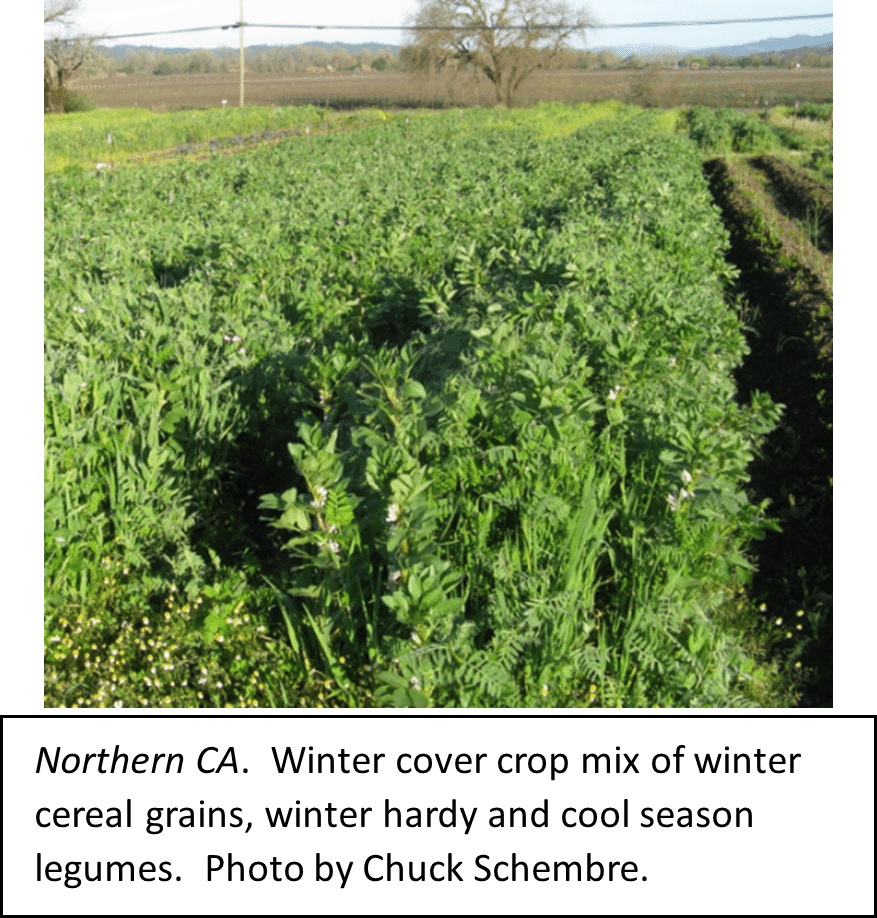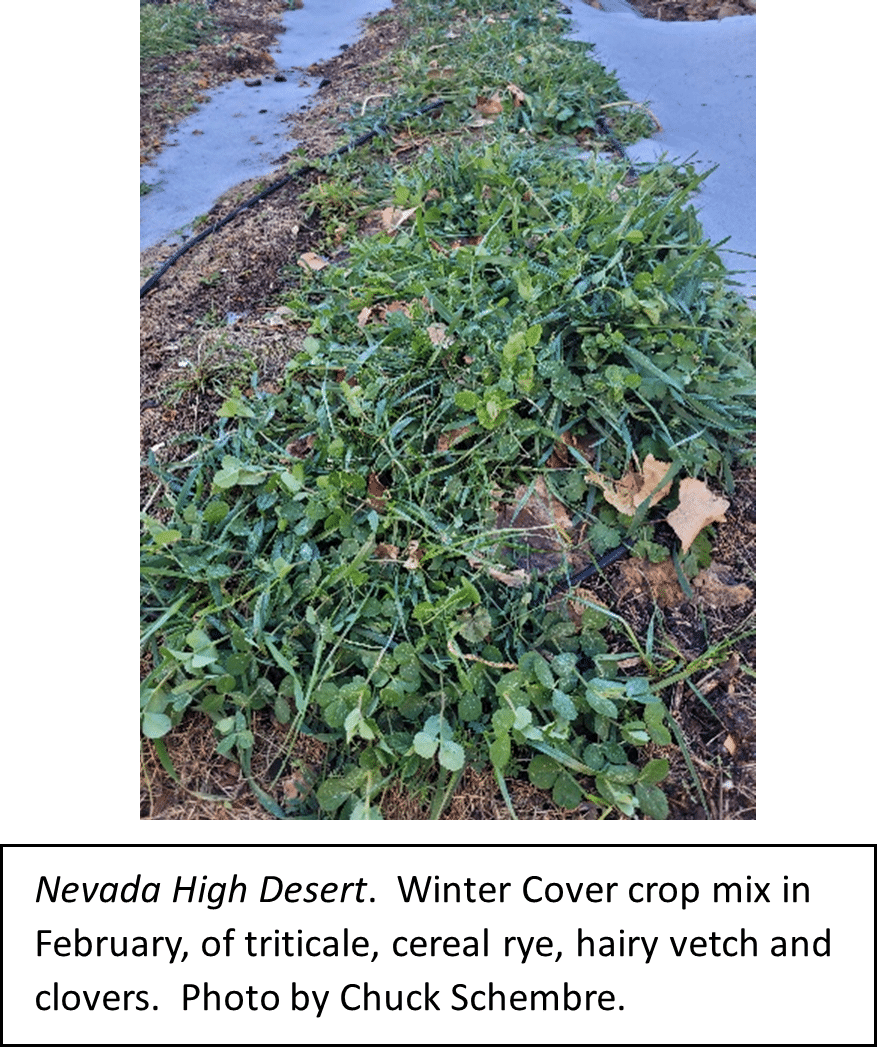Increasing Diversity in Market Gardens with Winter Cover Crops
By Chuck Schembre, Understanding Ag, LLC
Cover crops are one of the best tools for achieving many of the soil health principles - keeping the soil armored, reducing disturbance, increasing diversity, and maintaining a living root throughout the year. Cover crops are essential for increasing diversity, and diversity of living plants is paramount for building soil aggregation, coupled with a resilient and functioning soil microbial population.
Using a diversity of cover crops will increase plant root exudate diversity, which will attract a diversity of microbial species. This leads to numerous soil health and regenerative benefits, including better nutrient cycling and disease suppression.
Although other practices, like reduced or no-tillage are important for improving soil health and increasing mycorrhizal fungi, no-till without plant diversity has soil health building limitations. This is why cover cropping, especially winter cover cropping, is one of the best soil health practices in the vegetable farmer’s toolbox. With some crop planning and experimentation, they are easy to incorporate into crop rotations, albeit a bit more challenging in cold arid climates (USDA Plant Zones 7 and below).
Diverse vegetable farms and market gardens have a lot of crop diversity rotating around the field, but lack diversity within single beds. They often do not have living roots throughout the winter. Even if a bed is intercropped, such as tomatoes intercropped with basil, lettuce or marigolds, the diversity is still relatively low within each bed for extended periods of time. This is not enough diversity, and the row crop vegetable farmer continuously faces this challenge. Nature very rarely thrives with just two or three plant species comprising the ecosystem. We must intentionally attempt to mimic nature’s diversity to create regenerative market gardens. While it is not practical to grow tomatoes in the high diversity we may see in perennial pastures, we can add a level of diversity and produce profitable yields.
Winter cover cropping is part of the solution to breaking the low-diversity cycle. The plant root system (rhizosphere) is a biological hotspot. This is where soil microbes congregate and where soil aggregation is built. The continual addition of decaying and decomposing plant residues adds diversity of organic matter, which is important for building an adequate food source for soil microbes. If there are no living roots through the winter, and dead, decaying plant residues, then soil health in a vegetable farm becomes stagnant and degrades over time.
I have worked with cover crops in many different climates and farming systems. This includes mid-sized diversified organic vegetable farms, small-scale, one-acre market gardens, large-scale vineyards and orchards, and my home garden. I routinely consult with growers regarding the best cover crop options, timing, and termination methods. For most market gardeners, adding cover crops, especially winter cover crops, is daunting. Their biggest challenges generally include understanding how to better plan crop rotations, timing their cover crop windows, broadening their knowledge of cover crop species, proper seeding and termination methods without no-till equipment, being creative within your farm and climate context and repetition.

Market gardeners might not feel cover crops are critical to their operation because they are implementing many other soil health practices. For example, many small-scale farms or market gardeners are building soil health through minimal tillage, no-tillage, high cash crop diversity and rotations. They also copiously apply different mulches and compost. These farms and gardens tend to use high levels of inputs, including organic mineral amendments, dry manures, liquid fertilizers and biologicals. Many market gardeners have been very successful producing quality crops through these practices, albeit with high input costs.
In my own experience, I have encountered market gardens experiencing a myriad of issues, including yellowing of young plants, poor germination from direct seeding, nutrient deficiencies in long season crops and insect and disease pressure that is hard to control organically. The no-till compost mulch method so commonly used in market gardens can lead to high nutrient concentrations building up at the soil surface. This includes high levels of heavy metals, micro-metals, salts, phosphorus and potassium which can cause soil microbial disturbance and inhibit efficient nutrient cycling. So, caution must be exercised with composting.
Incorporating winter cover crops into your rotation will improve soil aggregation and allow you to begin reducing fertilizer and soil amendment inputs, including compost. This is because a diversity of cover crops will increase carbon inputs into the soil through enhanced root exudate production. This feeds the soil microbiome, which then increases soil organic matter and nutrient cycling. In addition, a living winter cover crop, or a winter-killed cover crop, provides food, habitat and refuge for microorganisms, insects, and other beneficial critters. This greatly boosts the farm’s ecology. Winter cover cropping can also open up other revenue sources by increasing winter forage for small livestock (i.e., pastured poultry).

Although it may not be possible to get a cover crop seeded to every square foot of the field every year, with some planning and commitment, you can begin to develop a system with planned rotations where every bed receives winter cover crops within a multiyear plan. In the following blogs about winter cover crops for increasing diversity in market gardens, I’ll explore some additional topics, including winter cover cropping timing and species selection, seeding and termination methods, planning rotations, using cover crops for intercropping and being creative within your context.
